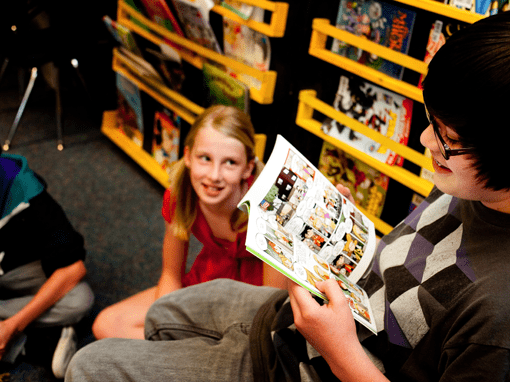So you’re an educator, and you’re wondering how to harness your students’ interest in comic books and graphic novels, to use an educational tool in your classroom?
Well, the good news is, you’re not the first person to ask this question.
And here’s even better news: there are plenty of answers out there for you, and we’re providing some of them here!
(Just as a note, portions of this article are excerpted from a more expansive article that we did: Why Use Comics To Teach? You should definitely check that link out for more great information on using comic books and graphic novels as educational tools in your schools or classrooms.)
“From verbal and visual literacy to critical thinking and memory, comics are a great tool to give young readers a head start.”
– “Raising A Reader: How Graphic Novels Can Help Your Kids Love Reading!”
That quote is from a book, written by Dr. Meryl Jaffe, which looks into how graphic novels can be effectively used to aid in helping students improve their reading skills.
As you explore our site, you’ll find that Pop Culture Classroom provides numerous free resources for educators, all designed to help you with using comic books in the classroom. This includes free educational comics, lesson plans, community programs, and so much more!
But I want to make sure we get you started in an easy and accessible way.
So in this article, I’ll just provide six quick, general ideas for using comics in the classroom.
Remember, comics and graphic novels are a medium, not a genre. That means that they aren’t all superhero stories (although we love superhero stories!). So you can find a comic book or graphic novel story that addresses virtually any topic that you might be interested in. Subjects in comics and graphic novels range from coming-of-age stories (“Blankets”) to war-torn childhood (“Persepolis”) to history (PCC’s “Colorful History” series).
Seriously, you can pretty much find a comic on anything these days.
With that in mind, you’ll likely want to select a comic book or graphic novel that fits within the subject you’re teaching, and don’t worry, there are plenty of options!
Once you’ve made a selection, you’ll want to read it, and identify the themes of the comic book/graphic novel you’re planning to teach from. After that, you’ll be ready to use those themes to engage your students in the following ways:
1. Art arrangement: This is essentially a discussion of how the book’s art (color, page design, lettering, panel placements, panel size, artistic direction) conveys the themes and emotions of the story. Exploring these elements also works towards teaching students how to determine the importance of a text, as indicated by the art.
2. Sequencing: Leading your students in a discussion that examines panels and stories, and how they are arranged, is a strong method of helping them easily understand order and sequence. For some students, studies have shown this to be even more effectively communicated through comics than in prose.
3. Art and themes: Have students work in small groups to choose particular panels or pages that most strongly exemplify the themes you want to discuss, and then have them identify how the art communicates these themes.
4. Current events: Often, once the themes are identified in a comic story, they can be used as a bridge towards leading a discussion about current events, which typically engages students in a new way, because of the relation to the comic story they’ve read.
5. Performance: If your students are able to read, you may want to treat the reading as a performance, assigning the out-loud reading of different characters to different students. You can encourage your students to come up with distinct voices for each of the characters, and see what other dimensions they can add to the story.
6. Script writing: You can design an assignment where students write on their own, using existing comics pages where you have blanked out the words. This encourages students to build a story by identifying and understanding the story that is communicated in the existing art.
So there you go: some basic steps to get you started in teaching your students with comics and graphic novels! And remember, there have been numerous studies in recent years that have shown how using comics in the classroom increases student engagement. So have fun with your students!
Write us and let us know how it goes! We’re always working on developing our resources to help out educators like you.
Oh, and be sure to subscribe in the top right of our page, for updates!
Pop Culture Classroom
9am-5pm Monday-Friday
Quick Links
Comics 101
For Educators
For Parents
For Students


